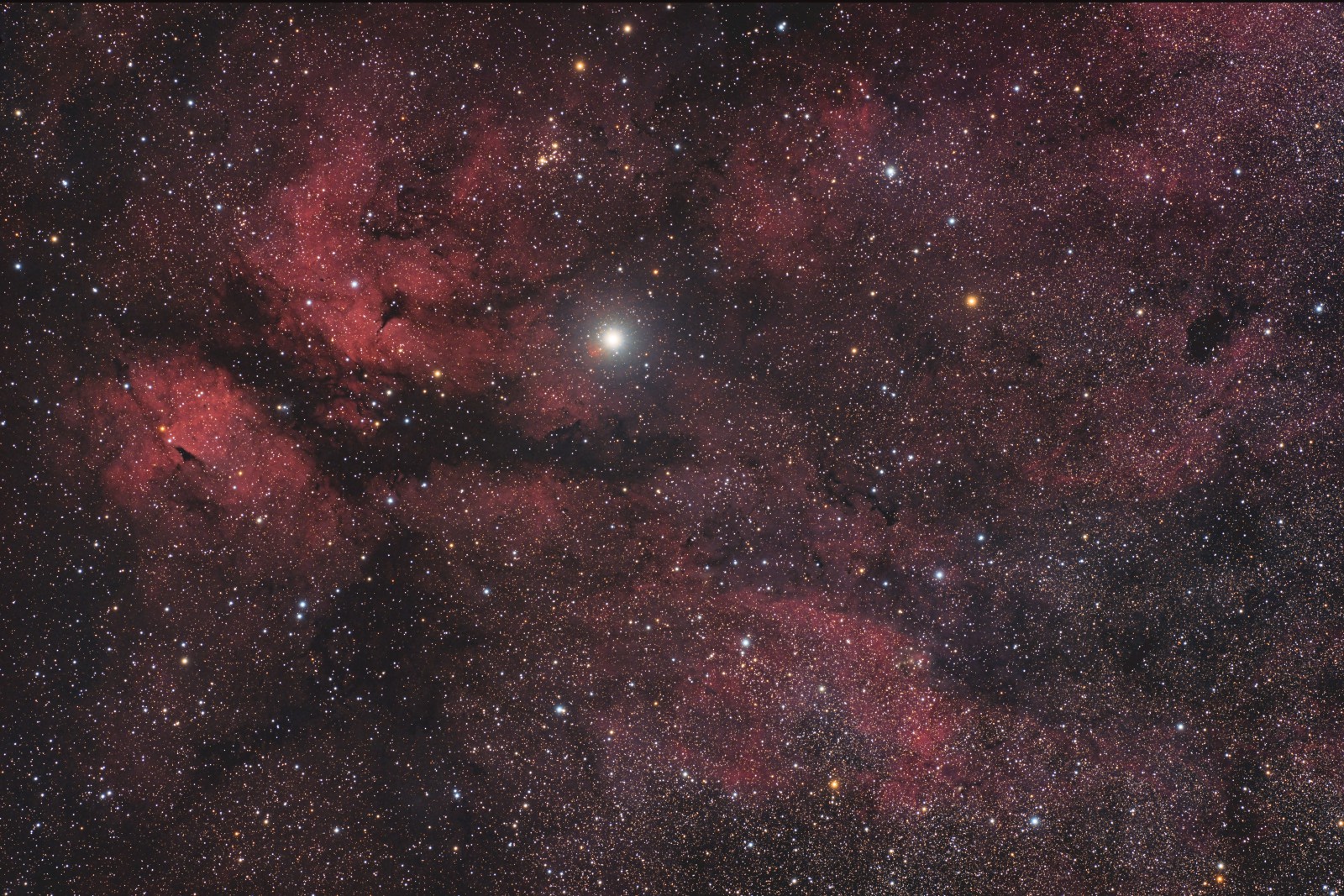γ-Cygni Wide Field (2021)
 Click here for full size image
Click here for full size image
August 7, 2021
About 10 days ago, lightening struck over our property and an electromagnetic pulse fried my main imaging mount. After moping for a couple of days (actually, clear nights), I took action: I moved my 4″ refractor and colour camera onto a smaller mount that I keep for travelling and occasional solar system imaging. After a shakedown cruise to get everything working well, I was able to capture this on the night of August 5, 2021. One of my goals in capturing this image was to highlight what can be achieved with one night in moderate skies (Bortle 5 or so), using a relatively simple workflow for processing.
There is so much going on this field of nebulosity in Cygnus! IC 1318 is the nebula surrounding gamma Cygni (γ-Cyg, Sadr), which is the brightest star in this image. Sadr is a naked-eye star, sitting where the body and wings of Cygnus, the Swan, cross in the sky. Cygnus is up very high in the sky for me in the summer and fall. Despite its appearance in this image, this nebula is actually faint and tenuous visually — the brightest parts are visible in a dark sky with a big telescope, but they look just like a faint haze in the eyepiece. It is challenging to see faint objects in this field through a telescope unless you keep Sadr out of the eyepiece field of view.
While enjoying the nebula, note the pretty star clusters in the image. NGC 6910 is to the upper left of Sadr. If you’re looking for a narrower field of view of this region, I’ve also imaged IC 1318 at higher resolution. I’ve also provided an annotated image that identifies some of the many dark nebulae in the shot.
Tekkies:
Acquisition, focusing, and control of Sky-Watcher HEQ6 mount with N.I.N.A., EQMOD and PHD2. Focus with Optec DirectSync motor and controller. Equipment control with PrimaLuce Labs Eagle 4 Pro computer. All pre-processing and processing in PixInsight. Acquired from my SkyShed in Guelph. Average transparency and seeing. Data acquired August 5, 2021 in a mostly moonless sky.
Takahashi FSQ-106 ED IV @ f/5 and QHY367C Pro one-shot colour camera with Optolong UV/IR filter
Data Reduction and Linear Processing Steps
Preprocessing: The WeightedBatchPreProcessing script was used to create a master frame. The OSC subs were integrated with DrizzleIntegration (CFA Drizzle x1).
Gradient Removal: DBE was applied to using Subtraction.
Colour Balancing: Colour was balanced with PhotometricColorCalibration.
Linear Noise Reduction: MultiscaleLinearTransform was used to reduce noise in the background areas, using an internal mask to protect bright structures. Layer settings for threshold and strength: Layer 1: 5.0 0.85, 2 iterations; Layer 2: 3.5, 0.75, 2 iterations.
Stretching: HistogramTransformation was applied to make a pleasing, bright image, with background set to an intensity of approximately 0.10.
Additional Processing
Nonlinear Noise Reduction: TGVDenoise was used in L*a*b* mode to reduce noise with a mask used to target the background areas and protect the stars and galaxy (max. 1,000 iterations and convergence selected).
Stretching: HistogramTransformation was applied a second time to make a pleasing, bright image, with background set to an intensity of approximately 0.10.
Contrast Enhancement: LocalHistogramEqualization was applied twice (scale of 40 with strength 0.25; then scale of 150 with strength 0.18) using a mask to protect stars and low-signal regions of the image.
Final Steps: Background, nebula and star brightness, contrast, and colour saturation were adjusted in several iterations using CurvesTransformation with masks as required. The DarkStructureEnhance script was applied with a strength of 0.2. ICCProfileTransformation (sRGB IEC61966-2.1; Relative Colorimetric with black point compensation) was applied prior to saving in jpg format.






Very nice!
Wonderful wide field of the region, lots of bright Ha and dark dust to explore.
Beautiful Image Ron, amazing processing job as usual. Sorry to hear about your mount, that is awful luck.
Wonderful image Ron, amazing processing job as usual. So sorry to hear about your mount, that is awful luck.
You don’t seem to use Starnet, is the right?
Not for this image